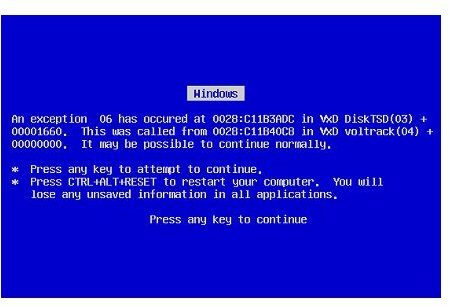MS Blue Screen Error Explained BSOD
What Is the Blue Screen of Death?
The Microsoft Blue Screen of Death – also known as Blue Screen of Doom, bluescreen, BSOD or Stop Error – has been the bane of standard Microsoft end users since the release of Microsoft Windows 1.0.
Although nothing more than a screen displaying diagnostic information, it has been ubiquitous with the perceived “poor quality” of Microsoft Operating systems, most commonly because it occurs on hardware upon which the operating system shouldn’t be installed, or because the hardware isn’t correctly installed, setup in the BIOS or even connected properly.
However in older versions of Windows, software bugs and badly written DLL files would cause the problem, as would inferior RAM and power supply units.
Understanding the MS Blue Screen Error
While the original BSOD in Windows 1.0 was nothing more than garbled white symbols on a blue background, following on from the success of another company using the phenomenon to display diagnostic information during the development of software for the OS/2 operating system, Microsoft began using the bluescreen to output a brief cause, details a trained technician could use, as well as instructing the user how to proceed.
In Windows 3.0 through to Windows ME, the BSOD would display an error code as well as advice to reboot the PC – however there would be little information on what caused the error (although specialist technical personnel might be able to debug the error based on the information provided). Similarly, in Windows 2000, Windows XP, Windows Vista, Windows 7 and the various NT-based server versions, the MS blue screen error might reference a memory location, as well as advice to use the Check Disk program.
(Image credit www.our-picks.com)
Bill Gates and the Plug and Play BSOD
A famous occurrence of the Blue Screen of Doom occurred at the COMDEX (Computer Dealer’s Exhibition) event in April 1998, during a demonstration of Windows 98 by Microsoft founder Bill Gates.
In front of a large live audience, whilst providing an overview of the new operating system’s Plug and Play system (the means by which the OS would detect new hardware and prompt the user to install the device drivers), a scanner was connected to a PC running the Windows 98 OS due for release later that year.
The resulting hardware crash lead Bill Gates to quip: “That must be why we’re not shipping Windows 98 yet.”
Improving the MS Blue Screen Error

While you might now appreciate the purpose of the error, you might wonder why it is still used. The main reason for this is the fact that Windows Vista and Windows 7 are developed from the same Windows NT architecture as Windows 2000 and Windows XP. There might well be other ways to express the same information to the end user – certainly something more meaningful in many cases, and at least a means to save whatever work was open when the crash occurred – however as we’ve seen, the error is always hardware based under Windows NT-derived operating systems.
Until Microsoft develop a new architecture from the ground up, it looks like we’re stuck with the MS blue screen error, or Blue Screen of Death!
(Image credit: blogs.microsoft.co.il)
